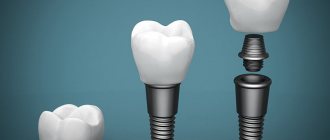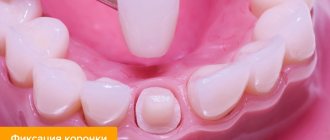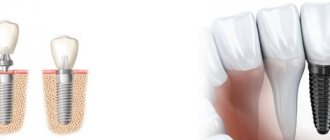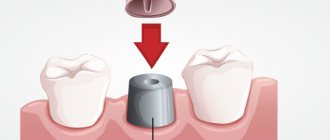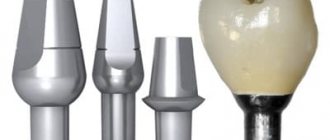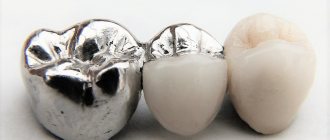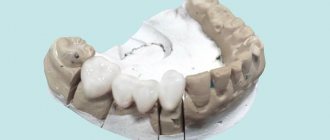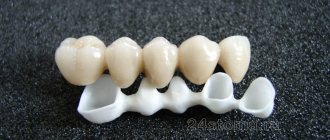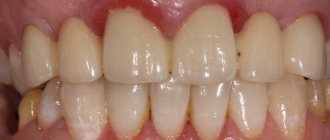Types of crowns for implants
What kind of crowns are placed on implants? Like regular dentures, implant-supported dental crowns come in a variety of types depending on the material. Today, the most popular materials used in the manufacture of crowns on implants are ceramics and metal-ceramics. Their main difference, as the name suggests, is the presence or absence of a metal frame in the design. Recently, it has become popular, for example, to install zirconium crowns on implants - all-zirconium or ceramic restoration structures made on a zirconium frame.
- Ceramic
Dentures made of ceramics are usually recommended to be installed in the area of the front teeth. Such structures are highly biocompatible, which means they do not have any negative effects on the soft tissues of the oral cavity. Plus, they look exactly like natural teeth. Ceramic crowns are more transparent, so in this case an abutment will be made of ceramic or zirconium. - Zirconium
Implant Crowns made from this modern material are most in demand by specialists today. The secret of their popularity is simple: they combine good aesthetic qualities and high strength. - Metal-ceramic
Metal-ceramic is perhaps the most common material used for the manufacture of dentures. Metal-ceramic crowns on implants for chewing teeth are inexpensive and reliable. They usually require a metal abutment.
The main mistakes a doctor makes when doing prosthetics
At the very beginning of our article, we said that when prosthetics on implants is important, the high quality of both the surgical stage of treatment and the stage of permanent prosthetics. If, when installing crowns on implants, the doctor makes inaccuracies or mistakes, the patient may not like the result of the implantation and, moreover, serious complications may arise after the restoration.
What mistakes are important to avoid when installing crowns on implants? Let's consider in detail:
- 1. Inaccurate crown manufacturing. If the crown does not have high anatomical accuracy and does not fit well to the neck of the installed implant, the soft gum tissue around the crown will be constantly injured, which is dangerous due to the occurrence and development of inflammatory processes.
- 2. Making a crown without taking into account the length of the implant, the thickness of the bone and gum, and the height of the gum.
- 3. Mismatch between the diameters of the crown and implant. This error can lead to soft tissue inflammation and bone resorption in the implanted area.
- 4. Unstable fixation of the abutment in the body of the implant. If the abutment is poorly fixed in the implant, the risk of inflammation in the area where the titanium rod is installed increases. Naturally, the mobility of the abutment in the implant also causes mobility of the crown.
- 5. Incorrect crown shape is a mistake that can lead to abutment breakage.
Any of these mistakes by the prosthetist can negate the results of the implantologist’s work and cause rejection of the installed implants - a complication that in most cases has to be eliminated by removing structures from the bone and lengthy and expensive treatment. In order not to waste your nerves, money, time and not to risk your health - before prosthetics with crowns on implants, carefully choose dentistry.
A good clinic should use the most modern and accurate diagnostic equipment and technologies that allow planning and predicting the results of implantation and prosthetics. Our premium dentistry in Moscow, Firadent, uses all the innovations that allow dental implantation to be carried out efficiently and safely for patients!
What is the best crown to put on an implant?
The answer to this question depends on the area being implanted and your budget. If we are talking about chewing teeth and the patient does not want to overpay, then the doctor will most likely recommend metal ceramics. Zirconium crowns for chewing teeth will undoubtedly be the best option. However, it is also more expensive. If prosthetics takes place in the so-called smile zone, then it is better to place a crown on a ceramic implant. She will look not only beautiful, but also absolutely natural.
Installing a crown on an implant
Installing a crown on an implant involves putting a specially machined crown on an abutment that connects it to the implant - an artificial root, while crowns for traditional prosthetics are made from casts of ground natural teeth and installed on previously prepared teeth.
How long does it take to place crowns on implants? It all depends on the clinical picture. If immediately after installation the implant is stable and there are no indications for delayed prosthetics, then the implantologist places a crown on the implant immediately. In the area of the chewing teeth, which are not visible when smiling, most likely, a crown will be placed several months after the final implantation.
Installation steps
- After installation, an abutment is placed on the dental implant. Essentially, it replaces the tooth stump that is left after preparing the tooth before installing a conventional crown.
- When the abutment is installed, the doctor takes an impression to subsequently make a permanent crown for the implant.
- The final stage of installing a dental crown on an implant is fixing the prosthesis to the abutment.
Crown attachment method
The connection between the abutment and the crown should be as strong as possible. During installation, additional fixation must be performed:
- using dental cement - works as a strong “glue”, the structure is permanent;
- using a screw - a screw mechanism is used on which the crown is attached. To do this, a hole is made in it, which after installation is closed and polished. With this installation, there is less risk of inflammation, but there is a greater risk of structural failure when screwing in the screw.
You have questions?
We will call you back within 30 seconds
+7
Fixation of the crown on the implant: screw and cement
There are two ways in which you can place a crown on an implant - screw and cement. Screw-retained implant crowns involve drilling a hole in a prefabricated crown, which is later sealed. A screw is inserted through it, passes through the crown and is screwed into the abutment. All this happens outside the patient's mouth. When the crown and abutment are securely connected, the latter is secured in a special hole in the implant. Cement fixation of a crown on an implant is similar to the installation of a conventional crown: it is glued to the abutment using special cement - a composite material, while the abutment is already securely fixed in the implant, and the installation procedure takes place directly in the patient’s oral cavity.
All of the above applies to permanent crowns - those that are installed some time after implantation, when the first period of engraftment passes. But in most cases, implantation involves the possibility of instantly loading the implant with a temporary crown.
How is it different from cement mounting?
Fixation with cement is performed in stages:
- The abutment is prepared, impressions are taken and the prosthesis is made.
- The cement is placed into the crown cavity and placed on the abutment.
- A special lamp is used to harden the cement.
Differences between the cement method and the screw method:
- There is no hole on the occlusal surface, which improves aesthetics.
- The installation process is reminiscent of classic bridges.
- No passive landing required.
- Replacing an orthopedic structure is difficult.
- The process requires more attention from a specialist.
Why are temporary crowns needed for implants?
Temporary crowns on implants are installed primarily for aesthetic reasons, so that the patient does not walk around with a “hole” in the mouth for the entire healing period. This is especially true for prosthetics in the smile area. In addition, the temporary crown, although not always fully functional, is still involved in speech and chewing. It is distinguished from a permanent crown by the material of production - light plastic, and therefore also by cost and weight. These parameters are important, since spending a lot of money on a temporary crown, which is not needed for a long period of time, is inappropriate, and loading a newly installed implant with a crown of full weight is dangerous. At the same time, externally, temporary crowns are practically indistinguishable from permanent ones, and therefore from natural teeth, their color is matched to the shade of the enamel of the surrounding teeth, all this allows you to hide the prosthetic process from prying eyes.
Impression of teeth using a 3shape computer scanner
If the patient wants to undergo the procedure of installing dentures at the highest level, with the possibility of achieving maximum aesthetic effect and impeccable functional parameters, then experts recommend opting for zirconium crowns or e.max glass ceramics. This involves the use of innovative digital technology 3shape, which ensures extreme precision both in the modeling of ceramic dentures and in the process of taking dental impressions.
The key advantage of using the above equipment is the absence of the need for physical taking of impressions, and, accordingly, the elimination of discomfort for patients associated with this process.
In addition, through the use of the improved “3SHAPE” program, based on the use of computer technology, specialists have the chance to study in detail the structural features of the jaws, examine the surface of the teeth, and also determine the bite as accurately as possible. Subsequently, the digital scan is transferred to the laboratory online. After the image enters the computer application, modeling of the future prosthesis immediately begins. Next, the production process of the e.max crown or zirconium structure itself begins.
It should be noted that if the computer application detects errors, the 3D image will be sent to the laboratory only after they have been corrected. This guarantees a highly accurate prosthetic result, and the ability to transmit images to dental technicians online can significantly reduce the time needed to create crowns.
Scanner 3shape Trios – 3D scanning of teeth »
Which is better, a crown or an implant?
When asking a similar question, patients most often mean the installation of dentures based on their own teeth and implantation. What is the difference between a regular crown and an implant? In order to install a conventional bridge, it is necessary to grind down the healthy teeth adjacent to the defect, which will begin to decay over time and the bridge will have to be lengthened. This cannot happen with an implant. Its installation does not affect the “neighbors” in any way, and its service life is not limited. Only the crown will have to be changed. The service life of crowns on implants is about 10 - 12 years, and in many cases reaches 15 years, while with traditional prosthetics, the crown must be changed every 5 - 7 years, grinding the teeth in a new way.
Types of products offered
Models differ in their functional purpose.
The temporary abutment on the implant is responsible for the formation of the gums. It is fixed immediately after the base is introduced and acts as a “plug,” blocking the path of bacteria into the wound and promoting the healing of the gums above it.
A standard implant abutment can vary in length and also have a different angle of inclination to the base, from 20 to 45 degrees. The angle of inclination is selected taking into account the individual characteristics of the patient in order to maintain the natural appearance of a row of teeth.
The monolithic product is made as a single whole, where the adapter is fused with the implant. Thanks to this design, the treatment process is significantly accelerated and gum injury is reduced.
An individual zirconium abutment for an implant is used in cases of non-standard occlusion and is made for a specific customer.
The design as a whole can be combined and consist of different components made from the following materials: metal, plastic, ceramics.
